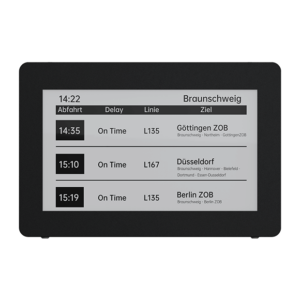Comparing Electronic Paper Displays with OLED and LED
Comparing Electronic Paper Displays with OLED and LED
Blog Article
Display technology has become an integrated element of our daily lives, appearing in everything from smartphones and e-readers to large-scale advertising panels. On the list of varied array of E paper display, OLED (Organic Light-Emitting Diodes), and LED (Light-Emitting Diodes) have surfaced as some of the very most generally discussed options. While every type serves its own unique function, their differences in functions, efficiency, and use cases cause them to become suited to certain applications. Let's take a closer consider the crucial characteristics of the display technologies.
Electronic Paper displays (ePaper)
Electronic Paper displays, also known as ePaper or Electronic Ink displays, are designed to simulate the appearance and readability of conventional Ink on paper. That engineering employs tiny microcapsules comprising charged dark and bright particles suspended in a definite fluid. When an electrical field is used, the particles proceed to either side of the capsule, making an obvious image. The picture remains static till still another electrical area is applied, rendering it ideal for displaying text-based material such as publications, magazines, and e-readers.

One of many principal advantages of ePaper displays is their minimal power consumption. Unlike standard LCD
Understanding Electronic Paper displays
An electronic Paper display (ePaper) mimics the looks of Ink on paper. Unlike standard screens, ePaper depends on its power to reflect surrounding light rather than emitting its own. This engineering not merely decreases vision stress but also gives unmatched readability in sunlight, which makes it suitable for e-readers and digital signage solutions.
One standout function of ePaper displays is their amazingly minimal energy consumption. Since they simply use energy when changing material, ePaper monitors are extremely efficient and suited to battery-powered devices. However, their renew costs are slower in comparison to OLED and LED displays, decreasing their applicability to fixed or minimally energetic content.
OLED displays
OLED displays are known for their spectacular aesthetic quality, providing lively shades, deep blacks, and excellent contrast. Each pixel in a OLED display emits a unique light, eliminating the need for a backlight. This not just provides for leaner, more lightweight types but in addition benefits in better energy efficiency compared to LED using scenarios.
One critical advantage of OLED displays is their flexibility. They could be made in circular or collapsible styles, creating them popular in cutting-edge smartphones and wearable devices. However, OLED monitors include problems, such as susceptibility to burn-in and smaller lifespans in comparison to other technologies.
LED displays
LED displays, the most frequent of the three, depend on a backlit process to gentle their pixels. While not as creatively striking as OLED E ink sign, LEDs are highly resilient, long-lasting, and cost-effective. These features make sure they are suited to a broader range of programs, including TVs, computer watches, and outdoor advertising.
LED displays an average of accomplish properly when it comes to lighting, making them a good choice for environments with high surrounding light. Nevertheless, they are unsuccessful in reaching exactly the same strong contrast and color precision as OLED technology.

Ultimate Contrast
When determining between ePaper, OLED, and LED displays, the decision depends mainly on the supposed purpose. For static content like studying or signage, ePaper excels having its minimal power use and large visibility in normal light. OLED shines in applications wherever vibrant shades and flexibility are paramount. Meanwhile, LED stays a reliable and cost-efficient alternative for many different general-purpose needs.
Each display technology brings something unique to the desk, ensuring that there's an ideal choice for every situation. Knowledge these variations might help consumers and businesses produce informed decisions that match their particular display requirements. Report this page